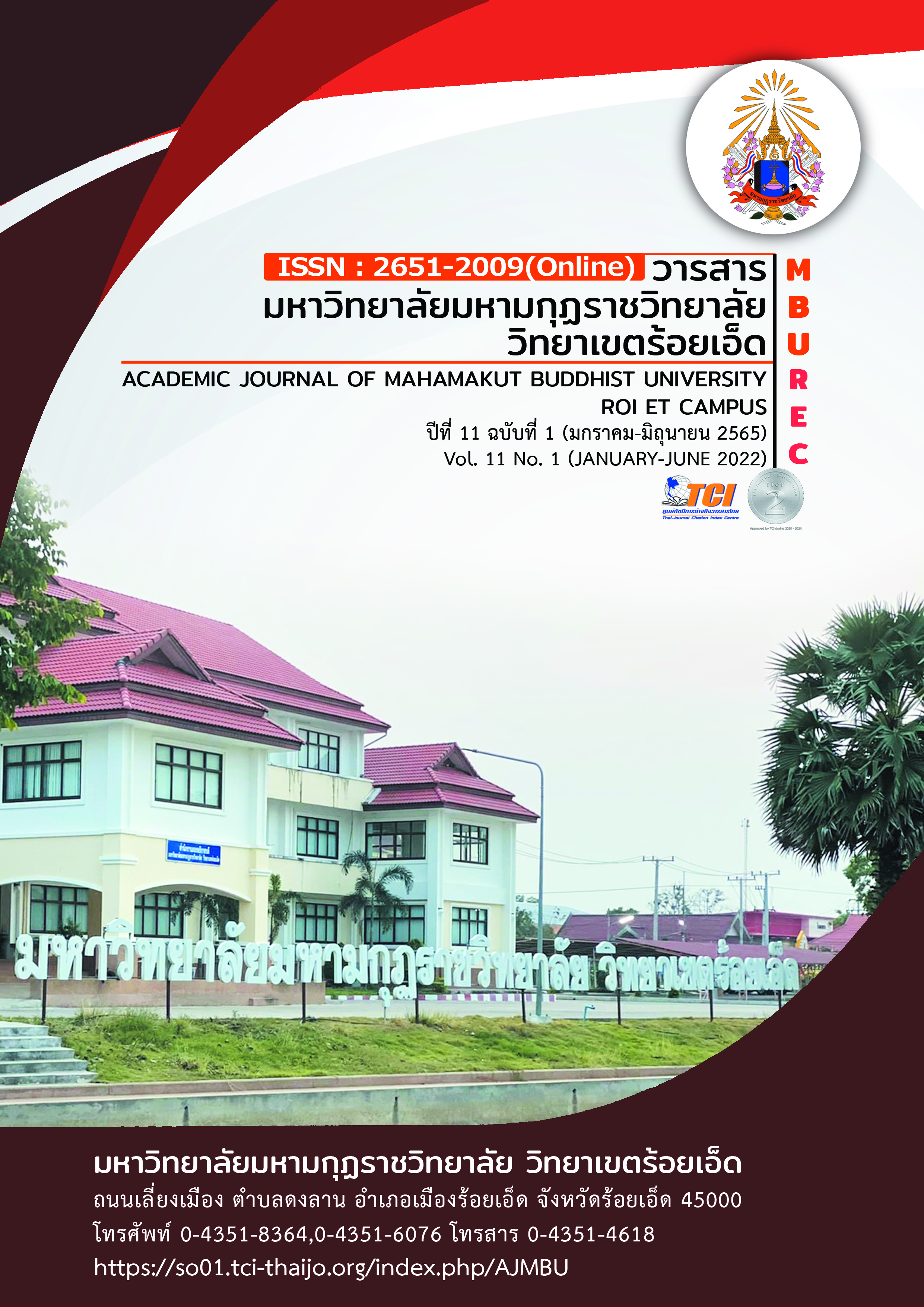THE DEVELOPMENT OF LIFE SKILLS INDICATORS OF THE HIGH SCHOOL STUDENTS IN THE SERVICE OF THE PROVINCIAL ADMINISTRATIVE ORGANIZATION
Main Article Content
Abstract
The objectives of this research article were 1) to develop the life skills indicators of the high school students in the service of the provincial administrative organization 2) to examine the coherence of the life skills model of the high school students in the service of the provincial administrative organization based on the formation and 3) to the development of the empirical data and were to generate the evaluation criteria, and life skills evaluation of the high school students in the service of the provincial administrative organization. This mixed method research. The participants were the school administrators, the head of academic affairs, the head of student affairs, and the chairman of basic education board that were chosen the multistage stage sampling to assure the life skills of the high school students in the service of the provincial administrative organization. The sample consisted of 520. The instruments used in this study were questionnaire. Data analyzed by using a computer program. Calculate the statistics such as mean, standard deviation. And create a model of life skill composition of high school students Under the provincial administration organization with the computer program.
The research results were as follow: 1. The result of the element development and life skills indicators of the high school students in the service of the provincial administrative organization revealed the 6 major factors 18 sup–features and 72 indicators which were 1) The major factor of creative problem solutions involved 3 sup–features 12 indicators 2) the element of decision involved 3 sup–features 12 indicators 3) the element of effective communication involved 3 sup–features 12 indicators 4) the element of building relationship involved 3 sup–features 12 indicators 5) the element of self-awareness involved 3 sup–features 12 indicators and 6) the element of emotional regulation involved 3 sup–features 12 indicators. The highest weigh value of the standard element was the element of the creative problem solutions. 2. The result of life skills constructive model coherent examination of the high school students in the service of the provincial administrative organization found that X2 = 3.998, df = 2, P-Value = 0.1355, RMSEA = 0.042, CFI = 0.999, TLI = 0.995, SRMR = 0.004, and the weigh value of the six life-skills indicators was at the 0.01 level of significance. The life skills indicator constructive model was in accordance with the criteria which gave on to the very good level of the construct validity and construct reliability. 3. The result of building criteria and the life-skills evaluation of the students in the service of the provincial administrative organization was suitable at the very good level.
Article Details

This work is licensed under a Creative Commons Attribution-NonCommercial-NoDerivatives 4.0 International License.
References
กมลวรรณ จีนหน่อ. (2553). การใช้กิจกรรมการแนะแนว เพื่อส่งเสริมทักษะชีวิต ด้านการจัดการเรียน เวลา และความสัมพันธ์ของนักเรียนชั้นมัธยมศึกษาปีที่ 1 โรงเรียนสาธิตมหาวิทยาลัยเชียงใหม่. การค้นคว้าแบบอิสระศึกษาศาสตรมหาบัณฑิต สาขาวิชาจิตวิทยาการศึกษาและการแนะแนว. บัณฑิตวิทยาลัย : มหาวิทยาลัยเชียงใหม่.
กระทรวงศึกษาธิการ. (2560). หลักสูตรแกนกลางการศึกษาขั้นพื้นฐานพุทธศักราช 2551 (ฉบับปรับปรุง พ.ศ. 2560). กรุงเทพมหานคร : สำนักงานคณะกรรมการการศึกษาขั้นพื้นฐาน.
กฤษณา ปัญญา. (2552). การสร้างแบบวัดทักษะชีวิตของนักเรียนในระดับชั้นมัธยมศึกษาปีที่ 6. วิทยานิพนธ์ศึกษาศาสตรมหาบัณฑิต สาขาวิชาการวัดและประเมินผลการศึกษา. บัณฑิตวิทยาลัย : มหาวิทยาลัยเชียงใหม่.
บุญชม ศรีสะอาด. (2554). การวิจัยเบื้องต้น. พิมพ์ครั้งที่ 9. กรุงเทพมหานคร : สุรีวิทยาสาส์น.
พิมพันธ์ เตชะคุปต์ และพเยาว์ ยินดีสุข. (2551). กระบวนการออกแบบย้อนกลับ. กรุงเทพมหานคร : สำนักพิมพ์แห่งจุฬาลงกรณ์มหาวิทยาลัย.
มนลดา กล่อมแก้ว. (2555). การสร้างแบบวัดทักษะชีวิตสำหรับนักเรียนชั้นมัธยมศึกษาตอนปลาย สังกัดสำนักงานเขตพื้นที่การศึกษามัธยมศึกษา เขต 1 กรุงเทพมหานคร. วิทยานิพนธ์การศึกษามหาบัณฑิต สาขาวิชาการวัดผลการศึกษา. บัณฑิตวิทยาลัย : มหาวิทยาลัย ศรีนครินทรวิโรฒ.
เมธาวี ธรรมานุภาพ และคณะ. (2545). ผลของการเรียนรู้ทักษะชีวิตเพื่อพัฒนาตนด้านความฉลาดทางอารมณ์ (ดี เก่ง สุข) ตามแนวคิดของกรมสุขภาพจิต ด้วยโปรแกรมการฝึกทางจิตวิทยา. กรุงเทพมหานคร : สถาบันราชภัฏสวนดุสิต.
ยงยุทธ วงศ์ภิรมย์ศานติ์. (2555). เด็กไทยขาดทักษะชีวิตเพราะระบบโรงเรียน ไม่ส่งเสริม. สานปฏิรูป. 5(55). 66-72.
รมณภัทร กตตน์วงศกร. (2557). การศึกษาผลการพัฒนาทักษะชีวิตของนักเรียนชั้นประถมศึกษาปีที่ 6 โรงเรียนบางจาก (โกมลประเสริฐอุทิศ) สำนักงานเขตภาษีเจริญกรุงเทพมหานคร.สารนิพนธ์การศึกษามหาบัณฑิต สาขาวิชาการบริหารการศึกษา. บัณฑิตวิทยาลัย : มหาวิทยาลัยศรีนครินทรวิโรฒ.
วันดี วิถี. (2554). ปัจจัยที่มีอิทธิพลต่อทักษะชีวิตของนักเรียนชั้นมัธยมศึกษาปีที่ 5 จังหวัดศรีสะเกษ : การวิเคราะห์กลุ่มพหุ. วิทยานิพนธ์การศึกษามหาบัณฑิต สาขาวิชาการวิจัยการศึกษา. บัณฑิตวิทยาลัย: มหาวิทยาลัยมหาสารคาม.
สำนักงานกองทุนสนับสนุนการเสริมสร้างสุขภาพ. (2554). ต้องทำอีกโพล. มติชน. 25(1276). 30.
Nelson-Jones, Richard. (1997). Group Leadership : A Training Approach. California : Brook/Cole.
Thompson; Rudolph; & Henderson. (2004). Counseling Children. 6th ed. New York : Brooks/Cole.


